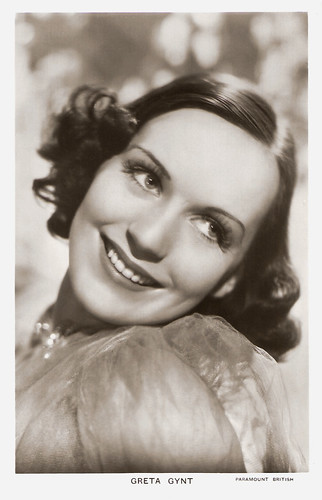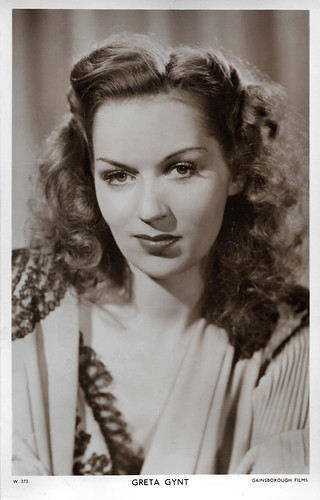
British postcard in the Picturegoer Series, London, no. 1409. Photo: Paramount British.

British postcard in the Picturegoer Series, London, no. W 373. Photo: Gainsborough Films.
Evil doctor Bela Lugosi's victim
Greta Gynt was born Margrethe Woxholt in Oslo, Norway, in 1916. Reportedly, she adopted the name Gynt after she heard a pianist playing Edvard Grieg's 'Peer Gynt Suite' in a hotel in London in the late 1930s. Her father was an engineer and her mother was a costume designer. As a child, she moved with her parents to Britain and started dancing lessons at the age of 5.
Eventually, they moved back to Norway. At age 12, she started as a dancer at the Chat Noir Show in Oslo. She made her film debut credited as Greta Woxholt in the Swedish film Sången till henne/The Song to Her (Ivar Johansson, 1934), her mother, costume designer Kirsten Woxholt, felt Gynt would have better luck in Britain.
She got a letter of recommendation from Fox Film and moved back to the UK. After a few small stage parts, J. Arthur Rank put her under contract, with the vain idea of making her into a British Jean Harlow. Gynt had a minor role in the romantic comedy It Happened in Paris (Robert Wyler, Carol Reed, 1935) starring John Loder, and a larger one in the comedy Boys Will Be Girls (Gilbert Pratt, 1937) and the crime film The Last Curtain (David MacDonald, 1938).
She was in the Tom Walls farce Second Best Bed (Tom Walls, 1938), the Fox Quota Quickie The Last Barricade (Alex Bryce, 1938) and the crime film Sexton Blake and the Hooded Terror (George King, 1938). The following year, she continued in such B films as Too Dangerous to Live (Anthony Hankey, Leslie Norman, 1939) and She Couldn't Say No (Graham Cutts, 1939) with Googie Withers.
Gynt had the female lead in the mystery The Arsenal Stadium Mystery (Thorold Dickinson, 1939). She played the mistress - and chief suspect - of a murdered footballer. In the same year, she was one of evil Doctor Bela Lugosi's victims in The Dark Eyes of London (Walter Summers, 1939), based on an Edgar Wallace story. In 1940, she appeared in Bulldog Sees It Through (Harol Huth, 1940) and The Middle Watch (Thomas Bentley, 1940) with Jack Buchanan, Two for Danger (George King, 1940) with Barry K. Barnes, Room for Two (Maurice Elvey, 1940) with Vic Oliver, and Crook's Tour (John Baxter, 1940) with Basil Radford and Naunton Wayne.

Vintage card. Photo: Eagle Lion.

Vintage postcard. Photo: M.G.M. Greta Gynt In Soldiers Three (Tay Garnett, 1951).

Vintage card. Photo: Eagle Lion.
An off-screen splash
Greta Gynt played a leading role in the drama The Common Touch (John Baxter, 1941). In Tomorrow We Live (George King, 1943), she is a French patriot who risks her life by becoming the mistress of a German commander to get information about U-boats. She continued with the comedy It's That Man Again (Walter Forde, 1944) with Tommy Handley, and was touching as Jewish cabaret singer Elsie Silver in the drama Mr. Emmanuel (Harold French, 1944) with Felix Aylmer. Gynt supported Sid Field in Britain's first major Technicolor musical, London Town (Wesley Ruggles, 1946), generally regarded as one of the biggest box-office flops in the history of British cinema. Stardom came when Gynt was given star parts in the crime films Dear Murderer (Arthur Crabtree, 1947) as a promiscuous murderess, and Take My Life (Ronald Neame, 1947) in which she was forceful as a loyal wife proving her husband's innocence.
She was top-billed in the comedy Easy Money (Bernard Knowles, 1948) as a nightclub singer singing - with her own voice - "The Shady Lady Spiv", and in the drama The Calendar (Arthur Crabtree, 1948). For a time she was under personal contract to Robert Siodmak. Gynt had a secondary but key role in the school story Mr. Perrin and Mr. Traill (Lawrence Huntington, 1949), as a school matron with whom two rival teachers (David Farrar and Marius Goring) were in love. After the British-Italian historical drama film Shadow of the Eagle (Sidney Salkow, 1950), she successfully sued the makers of the latter for money owed. She supported George Raft in the thriller I'll Get You for This (Joseph M. Newman, 1951), partly shot in Italy.
In 1951, Greta Gynt made an off-screen splash on two occasions. The first was at the 8th Army Alamein reunion at the Royal Albert Hall when she put her arms around Field Marshal Montgomery and gave him a big kiss. The photograph went around the world. The following month, her picture was widely seen when she turned up to meet the Queen, at the royal command film performance, wearing a silver lamé strapless gown, with silver hair, silver osprey feathers and a silver fox coat. Gynt's British films started to be regularly played on American television. This led to her receiving an offer from MGM to star in the American adventure film Soldiers Three (Tay Garnett, 1951) starring Stewart Granger, Walter Pidgeon and David Niven. Back in Britain, Gynt returned to "B" movies: Whispering Smith Hits London (Francis Searle, 1952), the Edgar Wallace mystery The Ringer (Guy Hamilton, 1952) with Herbert Lom, the comedy I'm a Stranger (Brock Williams, 1953), Three Steps in the Dark (Daniel Birt, 1954), Forbidden Cargo (Harold French, 1954) and Devil's Point (Montgomery Tully, 1954).
Ronald Bergan in The Guardian: "As a contrast to such melodramas, she was amusing as Penelope Toop, the former actress who had become a vicar's wife, in See How They Run (Leslie Arliss, 1955), based on the popular farce by Philip King. Now nearing 40, she might have found a new vocation in comedy had she pursued this vein of pictures." She acted in The Blue Peter (Wolf Rilla, 1955) with Kieron Moore, and My Wife's Family (Gilbert Gunn, 1956). She also appeared as a glamorous Saxon aristocrat in the 1956 episode The Friar's Pilgrimage of the British TV series The Adventures of Robin Hood. In 1957, Gynt had a supporting part in the British-American Film Noir Fortune Is a Woman (Sidney Gilliat, 1957) starring Jack Hawkins, and she took the lead in the thriller Morning Call (Arthur Crabtree, 1957). She starred in the episode Shadow on the Screen of the 1958 TV series The Invisible Man. In 1959, she took the lead in the comedy The Crowning Touch (David Wady, 1959) and had a support role in Bluebeard's Ten Honeymoons (W. Lee Wilder, 1959) with George Sanders in the title role.
Her last film was The Runaway (Anthony Young, 1963), in which she played the lead. The film was released by Columbia Pictures in 1966. Gynt was married four times. Her last husband was Frederick Moore, a plastic surgeon, who died in 1983. She semi-retired after marrying him and was out of the public spotlight by the mid-1960s. She was the sister of second unit photographer Egil "Gil" Woxholt who photographed scenes in such films as The Heroes of Telemark (Anthony Mann, 1965), On Her Majesty's Secret Service (Peter R. Hunt, 1969), and A View to a Kill (John Glen, 1985). Greta Gynt died in 2000 in London, England. She was 83. Bobby G at IMDb: "After retiring from the screen she lived in a luxury Kensington property known simply as 'Mrs Moore' and her career was sadly forgotten when she died in 2000. No television news show covered her passing nor was she honoured at the BAFTA Film awards during the annual tribute to film stars who passed away, which was a shame for someone so famous during the 1940s and 50s."

Vintage postcard. Photo: Metro-Goldwyn-Mayer.

Dutch postcard by HEMO. Photo: Eagle Lion.
Sources: Ronald Bergan (The Guardian), Wikipedia and IMDb.
No comments:
Post a Comment